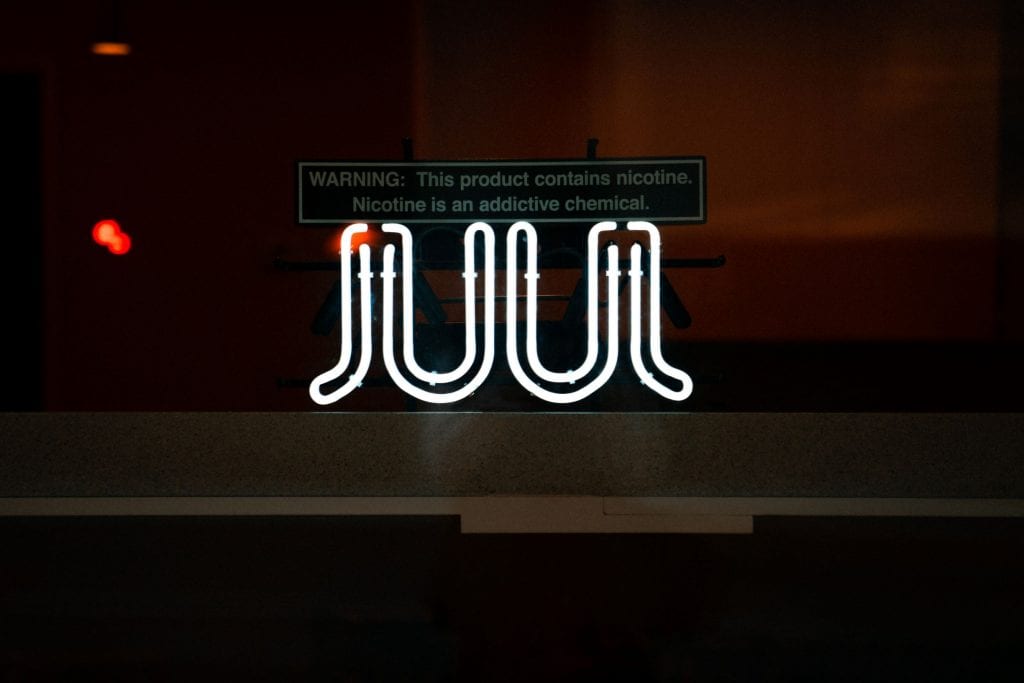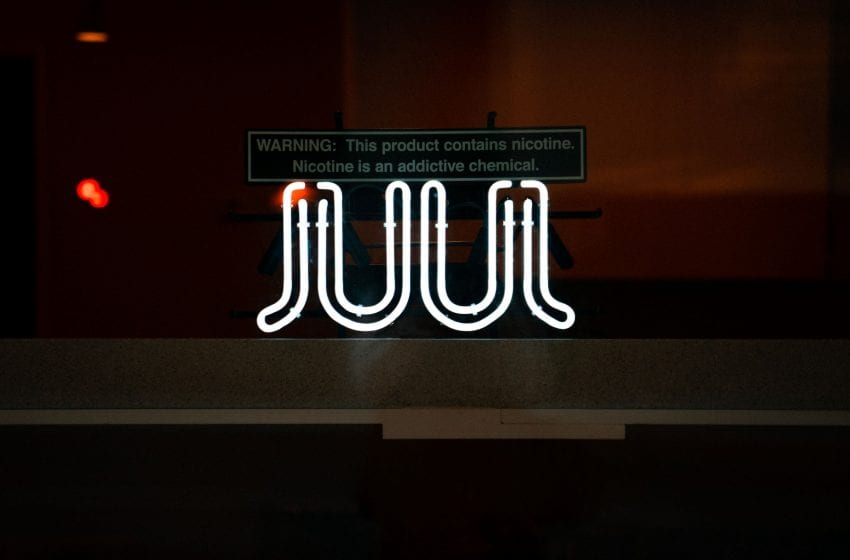
The rise and fall of Juul Labs
By Stefanie Rossel
It was the American Dream come true. In 2005, two frustrated smokers who had met at Stanford University developed an e-cigarette called Ploom and, two years later, started a business by the same name. In 2015, after the sale of Ploom and a name change to Pax Labs, they designed the Juul and established Juul Labs in San Francisco.
The novel product was different from other vapor devices on the market at that time. Resembling a USB stick, the Juul looked sleek and discrete. It was made for easy, intuitive use. The cartridge-based system worked with nicotine salt instead of free-base nicotine thus providing the user with a level of satisfaction comparable to that of combustible cigarettes. It also came with one of the highest nicotine contents among vapor products. Juul was a product with disruptive potential.
What followed was a story of rapid growth, the fairytale-like rise from a small company to a major player in the world’s largest vapor market that seemed too big to fail. Launched a year before the U.S. Food and Drug Administration (FDA) finalized its policy for regulating e-cigarettes as new tobacco products in 2016, Juul could develop with virtually no federal oversight. By the end of 2017, Juul became the most popular e-cigarette in the U.S. market. It was said to have revived the stagnating U.S. vapor market and became so popular that “Juuling” became a verb.
Competitors began to mimic the product’s sleek design and nicotine salt-based pod system. According to statista.com, the brand accounted for 82.9 percent of U.S. nicotine vapor sales in 2019. The company grew from 200 employees in 2017 to 3,000 in April 2020. Privately held, it was valued at $15 billion in July 2018. A few months later, in December 2018, U.S. tobacco giant Altria bought a 35 percent stake in Juul Labs for $12.8 billion. According to Wells Fargo, the deal valued Juul Labs at $38 billion. At the time, the company had an annual revenue of approximately $2 billion.
Yet soon after Altria’s entry, the tide began to turn. The company faced intensifying scrutiny from federal regulators and was flooded with legal challenges. With the colorful product design, discrete shape and a large variety of appealing flavors of its product as well as youth-oriented imagery and themes in its marketing, Juul Labs was held responsible for the steep increase in vaping among U.S. youth, which the U.S. Surgeon General in December 2018 labeled an “epidemic.” According to the 2019 National Youth Tobacco Survey, 5.3 million high school students were e-cigarette users, up from 3 million in 2017. With a share of 59.1 percent among high school vapers, Juul was by far the most popular brand among youths in 2019, the survey said. Something had gone wrong along the way for Juul.
“I think the crucial mistake Juul made was in being too careless about its marketing and its controls over who could get hold of the product,” says consumer staples specialist Jon Fell, principal at Ash Park, a financial analysis group. “Despite supposedly closely studying the history of the tobacco industry, Juul didn’t learn the right lessons, and the consequence is that a very successful product—with the potential to create a lot of public health benefits—became mired in a ‘youth use’ controversy which now threatens to drag the whole business under.”
Under attack
Claims put forward against Juul are manifold. The company was scolded for making unsubstantiated claims that its product helps users stop smoking and is safer than cigarettes, for increasing addiction with its high dosages of nicotine salts, and for its aggressive marketing to teenagers.
By Dec. 31, 2019, Juul Labs was a defendant in an estimated 340 legal cases. Several class action suits have been filed. There are complaints for damages, and on Feb. 25, 2020, 39 U.S. states announced an investigation into the marketing and sales of Juul vapor products. More lawsuits are to be expected.
Considering this negative outlook, Altria in October 2019 announced it had written down its investment in Juul by more than a third, recording a $4.5 billion pretax charge against its third-quarter earnings. In late January 2020, the cigarette maker again slashed the value of its investment by another $4.1 billion, citing mounting lawsuits against Juul Labs. Altria also revealed that it had revised the terms of its agreement with Juul. The tobacco firm said it would continue to help Juul navigate regulatory affairs but would discontinue all other services that were part of the original investment agreement.
Instead, Altria emphasized the U.S. rollout of iQOS and how this made its reduced-risk products (RRP) platform complete. One month later, Altria’s CEO Howard Willard said that he was “highly disappointed” in the performance of the company’s Juul investment. In April, Willard stepped down after 28 years with the company.
“I don’t think Juul was ever worth $38 billion, and Altria buying a 35 percent stake in the business for that price was one of the worst blunders I’ve ever seen a company make,” says Fell. The high market share assumed for Juul, he explains, related to scanner data for pod-based systems sold in a relatively small universe of convenience outlets. “But if you include all U.S. outlets and all vaping devices, including open systems, Juul’s share is much lower: around 42 percent when Altria bought its stake, and now around 39 percent—and down from a peak of 47 percent in Q3 2019, according to Altria.”
Fell believes it is sensible for Altria to have a portfolio approach to its RRP platform, which also includes nicotine pouches and traditional moist snuff products. “But I think Altria made a colossal mistake paying what it did for its Juul stake, and now Howard Willard has paid the price by departing the company,” he says. “It will be very hard, perhaps impossible, for Altria to make a good return on its initial Juul investment, but now the best it can hope for is to help Juul navigate the regulatory challenges it faces.”
In April, the Federal Trade Commission filed a complaint to force Altria to sell its stake in Juul Labs, alleging that the two companies had entered a series of agreements that eliminated competition in violation of federal antitrust laws.

A streamlining exercise
Under pressure from regulators, Juul began to make internal changes. In October 2018, it pulled all flavors deemed attractive to youths, such as mango, fruit medley and creme brulee, from U.S. retail stores, a measure that had little effect on overall sales, a study by the American Cancer Society from April 2020 showed: Sales of the remaining menthol and mint flavors doubled while tobacco-flavored products also experienced a significant rise in popularity.
In November 2019, Juul announced that it would also end sales of its mint-flavored pods. The company halted all broadcast, print and digital advertising in the U.S. and replaced its CEO, Kevin Burns, with K.C. Crosthwaite, an experienced Altria executive who had overseen the company’s expansion into cigarette alternatives, in September 2019. Several top executives left the company in October 2019 while the two co-founders stepped down from their positions of chief product officer and chief technology officer to take on advisory roles. In January 2020, the company named a “transformation officer.”
To prevent its product from being removed from the market, Juul Labs and other e-cigarette manufacturers must retrospectively submit a premarket tobacco product application (PMTA) to the FDA by Sept. 9, 2020. Industry stakeholders have raised concerns about the success of Juul’s PMTA.
While the stream of legal challenges, regulations and scandals does not yet pose an existential financial threat to Juul, it might negatively influence the surrounding social environment in the context of which regulators act, thus putting pressure on them to not approve the devices, a lawyer told Time.
Fell is more optimistic. “Juul is putting a massive amount of resource into its PMTA application, and I think they will make it in a way which seeks to address the youth-use issues,” he says. “Given the baggage they bring, it will probably be a very difficult process. But in the end, the FDA’s PMTA decisions have to be evidence-based, and if Juul files an application that includes enhanced user age verification measures and more limited flavors, it could be very difficult for the FDA to turn down. But it could be a long process, and I wouldn’t rule out legal challenges.”
Scaling back international expansion
Meanwhile, Juul Labs has embarked on a strict cost-saving and restructuring program. In recent years, the e-cigarette company had tried to expand its business overseas, entering several EU markets including the U.K., France and Germany, and Russia, Ukraine and Southeast Asian markets.

In May 2020, the company announced that it would end operations in South Korea, a year after it had entered the market with a product portfolio specifically developed for the country. There were also reports that the company would soon exit Austria, Belgium, Portugal, France and Spain. The news came shortly after Juul had announced that it would cut between 850 jobs and 900 jobs.
“I think there are a lot of reasons for Juul exiting various international markets, and the U.S. success was always going to be difficult to replicate,” Fell points out. “In the first place, I think talking up Juul’s international potential was one of the ways in which the owners of the business sought to get a higher valuation. But in many international markets, Juul faced significant competition from companies with powerful distribution. Because of its U.S. success, Juul also had to be sold at a price level which was quite high for several international markets—otherwise it ran the risk of the product being diverted back to the U.S. By the time Juul started to move more international, the U.S. youth use furor had already reached such a pitch that it also created quite a hostile public relations environment, sometimes with unhelpful regulatory consequences, such as a ban of Juul in Israel.”
Expansion into Asia was a key growth strategy for Juul. In China, Juul sales stopped shortly after the launch in September 2019, and in November the Chinese government effectively banned the online sales of e-cigarettes. “I think they will struggle [in China] unless they can find a good distribution partner, and also find a way to make a product which is affordable for the local market without running the risk of it being diverted to the U.S. I think Chinese vaping companies will provide tough competition in this region,” says Fell.
In the U.S., the company will move its headquarters from San Francisco to Washington, D.C., reportedly to be closer to regulators and to distance itself from “Silicon Valley’s growth-at-all-costs culture.”
“I think a certain arrogance in the Silicon Valley culture was responsible for a portion of Juul’s problems but also part of its success,” says Fell. “The company will probably become more conservative following the latest moves, and that might be necessary, but will it be able to maintain the spirit and culture of innovation which will be necessary if it is to succeed over the longer term? Five years from now, I expect Juul to have an important but perhaps smaller portion of a U.S. vaping market which, I hope, is itself considerably larger than it is now. I think its international business is likely to remain relatively small unless it can find a partner to help with distribution.”

